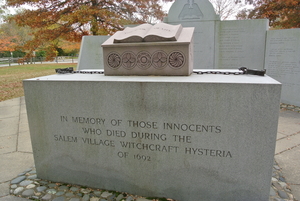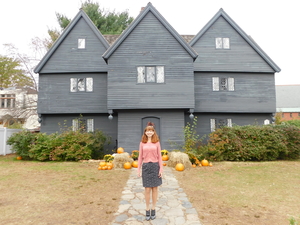Halloween Haunts: Hallowmas
By Katherine Kerestman
The Hallowmas Feast was held in The Cauldron Black, an occult shop in Salem, Massachusetts, on the wharf in Salem Harbor. It is a close space with black walls and a sound system playing chanting New Age music, an emporium selling shirts, hoodies, and other garments black and screen-printed with white occult symbols. The ware also includes wands, candles, boxes with many compartments, jewelry with pentacles and powers (crystals, pewters), books on various forms of witchcraft, incense and burners, poppets, many Egyptian figures, and oils.
The Hallowmas Feast began with participants processing into the inner room, the doorway of which is hung with black cloth serving as a veil between the worlds. The walls of the back room are painted black and hung with images of people dressed in modern occult (Goth) styles. Among both painted people on the walls and live participants, black was the overall fashion choice, accessorized with pewter jewelry, and icons of chalices and snakes and wands. The altar toward which the participants processed was draped in a black lace shawl, long fringes hanging over the table. Beneath the table candlelight flickered through the fringe. A skull, a wand, candles, powders, and other occult paraphernalia were arranged on the altar. Curious signs of obviously occult symbols, whose meaning were an enigma to me, were chalked or painted white on the black wood plank floor in front of the altar. A round table before the altar held a black iron cauldron.
A black-robed man in his late twenties or early thirties with kohl-bordered eyes, his light brown hair close-cut in front, and grown longer in back and tied into a Japanese-style top-knot, traced a circle with a bone (most likely an human ulna) on the skin of a drum, creating a whishing sound. Then he began Drumming up the Dead — those who were ancestors of our blood, bone, and spirit. As we observe the death of nature and approach of winter, All Hallows Eve is a time to reflect on our own mortality as well.
 Photo: The Witch Trials Memorial in Salem Village (now, Danvers)
Photo: The Witch Trials Memorial in Salem Village (now, Danvers)
The Wizard paid homage to the spirits and to the ancestors. He invoked first the blameless victims of the Salem witch hunt of 1692 and then the ancestors of The Craft (whom he called “The Mighty Dead”), and as he spoke he poured a large pinch of salt into a cauldron. As he repeated the same invocations several times, the Wizard added water, oil, and incense to the flames, as he worked to create a sacred space. Next, he picked up a white rose, removed several petals from it, and dropped the petals into a clear bowl of water, which he then stirred with the flower from which he had taken the petals – Offerings to the Gede Lwa. The Wizard then walked down the aisle between the rows of folding chairs, carrying before him the smoking incense (frankincense and myrrh), as the congregation waved their hands, gently wafting the smoke toward their own faces, as they inhaled the perfumed smoke.
Photo: The site of the Parris Parsonage , Salem Village (now, Danvers)
, Salem Village (now, Danvers)
Dancing with Death was next on the program. Two dancers performed — one at a time, not together. They were dressed in long black dresses, and they had scarves draped over their arms. They moved in Hindu-style movements, waving their arms and stretching their bodies before the altar, in time with the drumming. They were performing for the spirits.
Next, in Giving Voice to the Dead, a man led forward a blind seer, a tall, lithe woman, dressed in an ethereal white Grecian-style toga. She wore a paper mask on the top part of her face, a mask which seemed to be the top part of her face, but which covered her eyes (a trompe l’oeil). With a lovely voice, she sang a song about a flowing river, that we should follow.
Returning to the altar, the Wizard Justice performed a rite in preparation for breaking bread and wine in communion with the dead, and with the participants’ own mortality. One of the dancers, a tall, slender woman with black hair, wearing a long black gown took her place at one side of the altar. Across the altar from her was the Wizard. Each held a crescent-shaped knife, the blade up. They overlapped their blades above the altar. The woman held forth in her other hand the chalice of wine. The man held the bread in his. Communicants were instructed to break off a piece of bread, to touch their hands to skull on the altar, and to then touch their own foreheads. Partakers came forward in a line to receive the emblematic foods. Some drank the wine from the chalice, and some dipped their bread in the wine before eating it. Some knelt to receive the communion, and some received it standing.
After the ceremony concluded, everyone processed out from the inner room. The Wizard encouraged them to inhale the smoke in the doorway to cleanse excess energies they did not wish to carry with them, and to splash themselves with the bowl of rose water an altar attendant held in the doorway for them. They were invited to remain in the shop for a little while, to socialize or shop, or just to take some time to return to the mortal world from the spiritual realm in which they had been tarrying. Time was limited, though, for soon the shop was locked up and everyone was hurrying out to join the Nu Aeon (Temple of Nine Wells) candlelit procession from the Salem Wharf to Gallows Hill, where the victims of the 1692 Witch Hysteria in Salem had been hanged.
Across town, other people were gathering for The Witches Magic Circle in the Salem Commons. Thousands of people were creating concentric circles around the witches in the center who were leading the Samhein ceremony. The witches invoked the spirits of the four cardinal directions, and as they called upon each directional spirit they turned to face that way, and so did the people in the circles. The assemblage wore all manner of witch ensembles and Halloween costumes; they were of all ages, from children to the elderly. The presiding witches besought fellowship with each other, and with those who have preceded us in death, for Samhein is the day when the veil between the worlds is the thinnest. The people in the circles danced with the witches, in a stomping, aboriginal step, to the beat of the Dragon Ritual Drummers, as the ceremony was completed. When darkness descended people began to disperse and a dance band started to jam on the stage on the other side of the Commons. Fireworks would bring to an end this celebration of Halloween 2018 in Salem.
The Witch House in Salem  (home of Witch Trials Judge Corwin)
(home of Witch Trials Judge Corwin)
About the Author:
Once upon a time, Katherine Kerestman had earned B.A. in History & English, and an M.A. in English, and had embarked upon further studies in English — when a bite of an apple poisoned with pragmatism brought about a career shift which, in effect, strangled her artistic soul. Longing to romp in gothic ruins, crumbling castles, and claustrophobic Puritan and Shirley Jackson-esque villages, she began to write down her dreams, and suddenly they took wing as stories. She spent the next year writing her first book — Creepy Cat’s Macabre Travels: Prowling around Haunted Towers, Crumbling Castles, and Ghoulish Graveyard, which is now in the process of publication by WordCrafts Press!
Katherine has spent a good chunk of seven Octobers in Salem, Mass. She loves to indulge in all the witchcraft seminars and Samhein celebrations, dance at the Halloween balls, haunt the bookstores, and visit The House of the Seven Gables, and the graveyards and historical sites connected with the Witch Trials. You can find her frolicking in the cemeteries of Salem most Halloween nights
Photo: Author at the Mourning Tea in Salem




Loved this! It makes me want to travel.